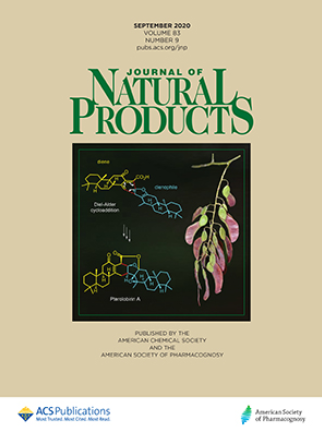Bioactive Cyclodepsipeptides from Cocultured Mangrove-Derived Aspergillus sp. and Penicillium sp.
IF 3.6
2区 生物学
Q2 CHEMISTRY, MEDICINAL
引用次数: 0
Abstract
Three new arthrichitin derivatives I–K (1–3) and three known congeners (4–6) were isolated from a coculture of mangrove-derived fungi Aspergillus sp. and Penicillium sp. using 1H NMR-guided fractionation. Their structures were determined by comprehensive spectroscopic analysis (1D/2D NMR, HRESIMS, ESI-MS/MS), Marfey’s analysis, DP4+ probability, and experimental/computed ECD comparison. All compounds were evaluated for antibacterial effects and cytotoxicity. Notably, compounds 1 and 5 showed weak cytotoxicity against MHCC-97H cells (IC50 = 20.1 ± 0.9 and 25.8 ± 0.4 μM, respectively). Compound 4 exhibited potent anti-BPH activity (IC50 = 0.36 ± 0.02 μM).

红树曲霉和青霉共培养的生物活性环沉积肽。
从红树衍生真菌曲霉和青霉共培养中,采用1H核磁共振引导分离分离得到3个新的青蒿素衍生物I-K(1-3)和3个已知的同源物(4-6)。通过综合光谱分析(1D/2D NMR, hresms, ESI-MS/MS), Marfey分析,DP4+概率和实验/计算ECD比较来确定它们的结构。对所有化合物的抗菌作用和细胞毒性进行了评价。值得注意的是,化合物1和5对MHCC-97H细胞具有较弱的细胞毒性(IC50分别为20.1±0.9和25.8±0.4 μM)。化合物4具有较强的抗bph活性(IC50 = 0.36±0.02 μM)。
本文章由计算机程序翻译,如有差异,请以英文原文为准。
求助全文
约1分钟内获得全文
求助全文
来源期刊
CiteScore
9.10
自引率
5.90%
发文量
294
审稿时长
2.3 months
期刊介绍:
The Journal of Natural Products invites and publishes papers that make substantial and scholarly contributions to the area of natural products research. Contributions may relate to the chemistry and/or biochemistry of naturally occurring compounds or the biology of living systems from which they are obtained.
Specifically, there may be articles that describe secondary metabolites of microorganisms, including antibiotics and mycotoxins; physiologically active compounds from terrestrial and marine plants and animals; biochemical studies, including biosynthesis and microbiological transformations; fermentation and plant tissue culture; the isolation, structure elucidation, and chemical synthesis of novel compounds from nature; and the pharmacology of compounds of natural origin.
When new compounds are reported, manuscripts describing their biological activity are much preferred.
Specifically, there may be articles that describe secondary metabolites of microorganisms, including antibiotics and mycotoxins; physiologically active compounds from terrestrial and marine plants and animals; biochemical studies, including biosynthesis and microbiological transformations; fermentation and plant tissue culture; the isolation, structure elucidation, and chemical synthesis of novel compounds from nature; and the pharmacology of compounds of natural origin.

 求助内容:
求助内容: 应助结果提醒方式:
应助结果提醒方式:


